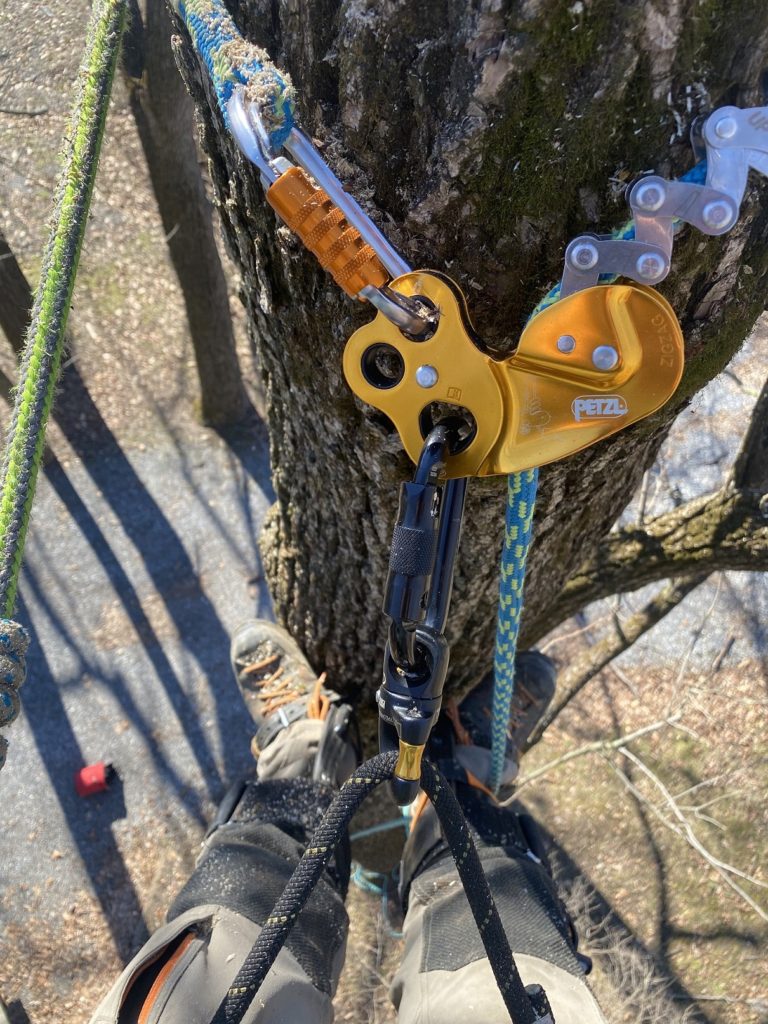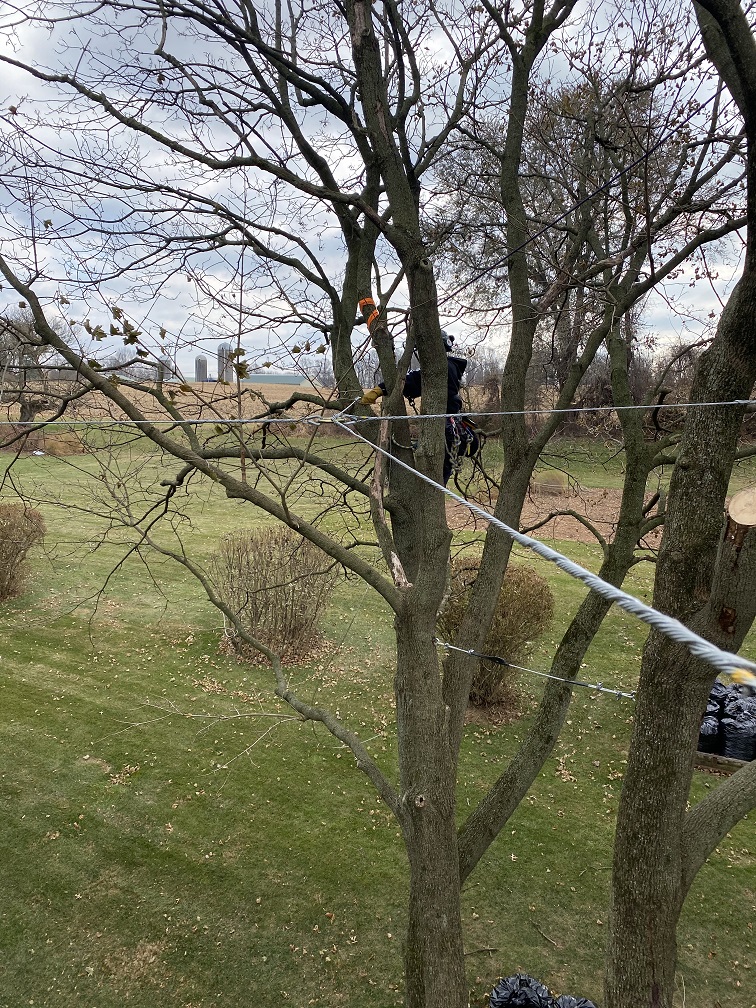What Is Tree Cabling and Bracing?
Tree cabling and bracing is the process of attaching cables and braces to weak limbs in order to prevent them from snapping under pressure. This proactive service ensures the structural integrity of trees, especially those that are diseased or damaged. Cabling and bracing can also be used to redistribute the weight of heavy limbs, allowing the tree to become more stable.
Cabling involves the installation of flexible steel strand cables in trees to reduce damage from high winds, ice, snow, or heavy foliage. The goal of cabling is to limit the movement of the supported branches so they are less likely to fail during storms. Attached with bolts, cables are generally installed in the upper regions of the tree canopy and must be inspected regularly to ensure their effectiveness.
On the other hand, bracing is the installation of threaded steel rods in the unions of weak branches and multiple stems to provide more rigid support. Braces are used to support heavy limbs, prevent the splitting of weak branches, and secure multiple trunks. Although bracing offers a more permanent solution for strengthening a tree’s structure, the combination of bracing rods with cables provides the most stable support.
Tree staking is another beneficial procedure for lending structural support to a young or newly planted tree. It involves the use of stakes and ties to secure the tree in an upright position, preventing it from leaning or being uprooted by wind and other external forces. However, stakes should only be used when necessary and removed once the tree is strong enough to stand on its own. Over-staking can hinder the tree’s natural growth and development, so it’s important that a trained professional perform this as well as other tree support procedures.
Tree cabling and bracing can provide a number of benefits to both homeowners and businesses — including added safety, increased property value, and improved energy efficiency.

Why Is the Cabling and Bracing of Trees Important?
Safety: Tree cabling and bracing reduces the risk of property damage and personal injury by preventing the failure of weak branches or entire trees. This is particularly beneficial in areas prone to severe weather, where the risk of falling branches is higher.
Increased property value: From a financial perspective, well-maintained trees can significantly boost property value. In fact, studies show that well-landscaped properties are valued 5-20% higher than the base value.
Energy efficiency: Trees can also improve energy efficiency by acting as natural heat shields. In the summer months, they provide shade and can reduce the temperature in their immediate areas by up to 10 degrees Fahrenheit – thus reducing cooling costs. In winter, well-structured trees divert cold winds that can increase heating bills.
Save Your Damaged or Transplanted Tree
When it comes to your tree, cabling and bracing can be a lifesaver. By providing additional support to weak branches and limbs, this service helps to prevent premature breakage and death of the tree. Consequently, trees that receive appropriate and timely cabling or bracing can enjoy an extended lifespan, continuing to provide their manifold benefits for years or even decades longer than they might have without such interventions.
Cabling and bracing services play a crucial role in securing newly transplanted trees as they establish their root systems. The transplantation process can be stressful for trees, leaving them in a vulnerable state where they are unable to effectively withstand winds, heavy snow, or the weight of their own canopies. By installing cables and braces, experts can offer these young or recently relocated trees the additional support they need during this critical phase.
How Much Does Cabling and Bracing Service Cost?
The cost of tree cabling and bracing services in Lancaster and Chester counties varies widely depending on several factors such as the size and number of trees, location, and the complexity of the job at hand. On average, homeowners can expect to pay between $350 to $600 per tree for a professional tree cabling and bracing service. More complex jobs or those involving larger trees may cost more, potentially exceeding $1,000 per tree. At Reaching Higher, our professional arborists are available for a free on-site consultation to assess the full scope of the work needed, along with associated costs.
In the long term, cabling and bracing offer a relatively cost-effective way to preserve the structural integrity of trees. Remember, investing in proactive tree care can help to avoid costlier problems down the line, such as property damage or tree removal.
What Are the Warning Signs for Trees Needing Cabling and Bracing?
In order to prevent potential damage and ensure tree health, it is important to look out for warning signs. Here are some situations where cabling and bracing may be required:
- Weak branch unions: If you notice two branches growing very closely together, forming a tight “V,” this could indicate a weak union that needs support.
- Cracks in the trunk or major limbs: Significant cracks might suggest that the tree is losing its structural integrity, which could be remedied with bracing.
- Excessive leaning: Although some trees naturally lean, excessive leaning or a sudden change in the tree’s angle could indicate a serious problem.
- Heavy canopies: Overgrown or heavy branches at the top of the tree could cause stress on the lower branches and trunk.
- Previous limb failure: If your tree previously lost a limb, that might indicate that other limbs could benefit from cabling.
- Multiple trunks: Trees with more than one trunk have a higher chance of splitting, particularly if they are mature trees.
- Diseased or damaged trees: Trees that are diseased or have suffered damage from storms or other incidents may require cabling or bracing.
If any of these signs are present, give Reaching Higher a call. Our skilled arborists will inspect your trees to diagnose any structural deficiencies that present a risk to your tree and surrounding property. We will then advise you if your tree can benefit from a support system like cabling, bracing, or staking.
In determining the best course of action for an ailing tree, our tree doctors weigh the risks and rewards. At times, a tree is so weak that it is beyond the point where a support system can offer any benefit; in such cases, we recommend tree removal.

Can You Perform Cabling and Bracing of Trees Yourself?
Tree cabling and bracing is a task that requires extensive knowledge, precision, and experience. Due to the potential for damage and harm, it is not advisable for untrained individuals to attempt this task themselves. Incorrectly installed cabling and bracing can exert improper forces on the tree, leading to structural damage, decay, or even death of the tree. In addition, there is a significant risk of personal injury and property damage from falling branches or from the tree itself.
Tree Cabling and Bracing in Lancaster and Chester Counties
You can trust Reaching Higher’s qualified arborists to inspect, install, and maintain your tree’s cabling and bracing systems. Our tree doctors are trained in ANSI A300 standards and have the experience to determine and install the most effective and least damaging support method. We also offer regular maintenance to keep your trees strong and healthy.
Don’t forget, most of the structural defects that require supplemental support systems could have been prevented through proper pruning and maintenance. With the right kind of assistance, you can ensure a safe, healthy future for your trees—and your home—for years to come.
If you live in Lancaster or Chester county and have a tree in need of cabling or bracing service, contact us today at 717-502-4707 for a free quote!
Request a Free Cabling and Bracing Quote
"*" indicates required fields